Archive for the ‘Guides and Information’ Category
Tuesday, May 25th, 2010
Cleaning is never fun and easy but, it is something that must be done from time to time.
What we use in the store is a polish that is designed specifically for the high polish pianos. Although the easiest and simplest way to do the cleaning is by using a very soft and lintless cloth like a cheesecloth or old soft T-shirt works wonders. I say to dampen the cloth a little but only to the smallest extent and my adage is to wash your hands, rinse the soap off well and then dry them on the cloth that you are going to use to dust. In other words very lightly damp.

If your piano has a wood grain or a satin finish then do the same thing except be sure to wipe with the grain of the wood. NEVER EVER use furniture polish to clean your piano. It is not good for the piano and it will take a long time to get the residue off.
Use the same technique when wiping off your keys. DO NOT use polish or cleaner of any kind EVER to clean your keys. If they are ivory this is not good at all because in many cases it will cause the ivory to absorb the polish and the keys will simply come off.

Here’s the tricky part. If you have a grand piano dust will inevitably get onto the soundboard of the piano (that piece of wood that is under the big metal plate) and if you are like me at all this will make you insane. Please do not attempt to clean that yourself. Call a certified technician which you can find at www.PTG.org and tell them you need to clean your soundboard and have your piano tuned. Paul McCloud at Accutone Piano Tuning www.pianoservsd.com is the guy we use here at PianoSD.com in Mission Valley in San Diego, California.
If you live in a particular humid area of San Diego for example like Carlsbad or La Jolla, you will notice that the dust will “stick” to the soundboard a little more than if you live in a drier climate like Rancho Santa Fe or San Marcos. In the cases that the climate is a little drier you will notice that the dust gets in quicker but is a little easier removed. However, in either case please call a certified tech to come out to do the work at his next tuning, but, let him know when you set your appointment that your piano needs a thourough cleaning that way he is prepared.
If you need some polish that is designed specifically for the piano you can find it here at PianoSD.com.
Drop by and say hello sometime we would love to meet you.
Ric Overton
Tags: Accutone Piano Tuning, California, Carlsbad, certified technician, La Jolla, Mission Valley, Paul McCloud, piano, Rancho Santa Fe, Ric Overton, San Diego, San Marcos, www.pianoservsd.com, www.PTG.org
Posted in Guides and Information, News, Ric Overton | Comments Off on Cleaning Your Piano
Monday, May 24th, 2010
I hear more than my share of talk about real or fake pianos. Some people have actually commented that they don’t like fake pianos. They were talking of course about digital pianos.
Although there are certainly some arguments about accoustic vs. digital pianos, there are still people who would prefer accoustic pianos over digital pianos. I recently had a discussion with a gentleman from Carlsbad who told me that he was convinced that the digital piano was a terrible thing to learn on – that is until he actually sat down and played one. He was so overjoyed with the digital piano that he purchased one on the spot.
We have many piano teachers who are turning to digital now too. Teachers are finding many ways to use digital that was never possible before. You can record, use computer functions to help you compose, always in perfect pitch, automatic transpose, easily transportable, heat and humidity dont effect it at all, several voices to choose from which give you the capabilities to play and entire orchestra score with recording and really the list goes on.
httpv://www.youtube.com/watch?v=KpnsZKmuO0Q
Of course, the accoustic piano will never disappear but, we are finding that more and more people are turning to digital pianos as an alternative for use with more demanding music that is being performed today.
The touch is very realistic and the sound is incredible. I know when I was first introduced to the idea of digital piano I was not completely sold, however, once I understood the basics of how digitals operated I was just absolutley thrilled with the possibilities that the digital world opened to me.
We have customers from many parts of San Diego such as Rancho Santa Fe, La Jolla and San Marcos that have become real fans of the Roland digital pianos because of thier realism in touch, tone and clarity of sound. More information can be found at www.RolandUS.com
If you have any questions or comments feel free to let me know and I will try to help you. Feel free to stop by our store located in the heart of Mission Valley in San Diego, California.
Stop by and see us we would love to meet you.
Ric Overton
Tags: accoustic vs. digital pianos, California, Carlsbad, digital pianos, La Jolla, Mission Valley, piano teachers, Rancho Santa Fe, Ric Overton, San Diego, San Marcos, www.RolandUS.com
Posted in Guides and Information, Lessons and Tutoring, News, Ric Overton | 1 Comment »
Sunday, May 23rd, 2010
I wanted to take a few minutes and talk about voicing on the piano.
When you purchase a new piano you will find nuances about your piano that make it individual. The tone of the piano is generally the one thing that stands out immediately. Perhaps you like a brighter sound or more mellow sound a full sound or more thin sound. It all depends on you and your likes. I happen to lean to a tone that is round and full but at the same time a little more stable than the next person.

Generally, all of the things I have just spoken about can be dealt with through a process called voicing. Voicing involves the shaping of hammers, and addressing the density of the felts on the hammers. Hammers have an ideal shape. Each hammer should strike each one of the strings in their particular set. In other words, each note has either one, two or three strings. When the hammer comes up to strike the string each string should be struck in order to hear the complete sound of the intended note.
The hardness of the hammers will have a huge effect on the tone as well. Once we have been able to determine your taste then we must set the hardness of each hammer. If the hammer is harder then we have to pin the hammer. We use a device that actually goes into the hammer itself and then moved around a little to seperate the wools in the hammer and actually make it less dense to produce a more mellow tone. If the hammer is softer then we have to iron the hammer making the wools more dense and creating a more bright sound.

Paul McCloud of Accutone Piano Tuning www.pianoservsd.com does a lot of voicing for us. We want the piano to sound very good when the cusomter makes their initial trip into PianoSD.com in Mission Valley, San Diego, California. After the sale if we need to make some changes then we can. Its often hard to drive from La Jolla or Rancho Santa Fe to go through this process so we can actually do this in a persons home in a short amount of time.
The differences in humidity, heat and sunlight can also techinically have an effect on the voicing of the piano too. If you live in Carlsbad as opposed to San Marcos you may need to make a certain amount of allowances for that as well. Only a technician can decide that for you.

The Standard of Excellence
In any case, voicing of your hammers should never ever be attempted by someone without experience so a qualified technician should be able to help you. If you are in San Diego area I of course, would suggest Accutone Piano Tuning at www.pianoservsd.com of you can visit www.PTG.org to find a technician in your area.
Stop by the store sometime, we would love to meet you.
Ric Overton
Tags: Accutone Piano Tuning, California, Carlsbad, hammer voicing, La Jolla, Mission Valley, Paul McCloud, piano hammers, piano technician, Rancho Santa Fe, Ric Overton, San Diego, San Marcos, www.pianoservsd.com, www.PTG.org
Posted in Guides and Information, News, Ric Overton | Comments Off on A Guide: What Is Piano Voicing?
Saturday, May 22nd, 2010
I just read an article from www.PianoWorld.com that discussed finding the one. The “one” of course being the piano of your dreams. The one she found was an old piano that was in not so great of shape but the one that she really liked the best.

It is vitally important when you are choosing a piano that you find the one you love. It may not meet the idea that you started with or what you had in mind when you started looking. The name brand is far less important than the tone, touch and clarity you get when you play the piano of your dreams.
Of course you have to look at the overall condition of the piano and have a piano technician like Paul McCloud at Accutone Piano Service www.pianoservsd.com go out and be sure there is nothing technically wrong with it. The move is the second thing to consider which you can find a qualified piano mover through Precision Piano Moving www.precisionpianomoving.net .
Location is also an important thing. If you live in La Jolla for example that is a little more humid than say Rancho Santa Fe. Or if you are in Carlsbad as opposed to San Marcos you must be aware that humidity levels may need to be addressed.

The most important thing to consider is whether or not you like the piano and the guy that is selling it to you. If you love the piano-buy it.
There are several questions you have to ask yourself BEFORE you buy the piano that you have been looking for. We hope that you will feel welcome at PianoSD.com in Mission Valley in San Diego, to visit, ask questions and perhaps get a little education if you need it. We always welcome those discussions about the piano. We are all very passionate about the instrument and would lobe to be able to put a piano in your home or direct you to the right place to buy what you are looking for.
If you have any questions that I can help with please feel free to let me know or simply drop by the store sometime and say hello. We would love to meet you.
Ric Overton
Tags: Carlsbad, La Jolla, Mission Valley, Precision Piano Moving, PrecisionPianomoving.net, Rancho Santa Fe, Ric Overton, San Diego, San Marcos, www.pianoservsd.com
Posted in Guides and Information, News, Ric Overton | Comments Off on Finding the one
Wednesday, May 19th, 2010
I am (unfortunately) a lover of older uprights. We recently took in an old piano that was from 1889 that was in really, really, bad shape at first glance. Waiting for the opportunity to go to the local dump, I took a shot at some new refinishing products, just to see how they worked and “low and behold” the finish under the black and grey exterior was an absolutely beautiful burled walnut.
I spent the next few days working on the finish while a tuner friend began to “try his hand” at the older action parts and such. It was more a labor of love and to gain some experience than anything else. After a few bucks in parts, the piano was sounding pretty good. By this time we had named the piano, you know guys have to name everything for some reason, Carla. The tech was leaving for a few days and I put a note on the piano that said “I’ll miss you while you’re gone” and signed the note “Carla”.
The next week a lady came in searching for a particular piano that we had in the back of the store, we went back and after playing the piano that she had come to see started to leave and noticed “Carla” over to the side. She immediately walked over to the piano, asked who Carla was and I explained that it was just a name we had made up as a joke and it stuck. She began to cry and told me that her twin sisters name was Carla and that she would buy the piano when we were finished with it.
After we delivered the piano and some months later the customer called to tell me that only a few days after she got the piano in her home she was diagnosed with cancer but, the piano had made her recovery so much easier because she felt and immediate attatchment to it.
Sometimes, its the unexpected surprise that makes it all worth while.
Ric Overton
Tags: piano technician, Upright pianos
Posted in Guides and Information, News, Ric Overton | Comments Off on Neat story about a customer of ours
Sunday, May 16th, 2010
For many years I have been a fan of gospel music. I love four part harmony and really enjoy the sounds of 4 professional voices that sing on pitch in harmony correctly.
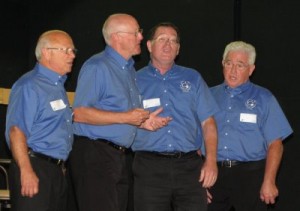
Picture from the Four Part Harmony.
As most of you know, I am from the South. Of course, gospel music was part of our culture and church on Sunday morning, but, for me it was much more than that. I still remember the day that it all finally made sense to me. I was about 6 or 7 (not telling you the year) and my mom put an album (yes the round black record thing that played on a stereo system called an LP) of a group that I have loved for many years called The Happy Goodman Family. I was forever lost to the sound.
I lived, drank and ate the Goodman Family. I loved the music they sang and I loved the songs. I soon began to learn to play the piano and threw myself into this style of playing. By the time I was 15 or 16 I was traveling with a gospel group that traveled from Florida to Michigan and most of the spots in between. I was in heaven.
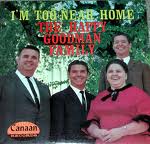
Goodmans 1962
This afternoon one of our associates at PianoSD.com in Mission Valley in San Diego, California was by the store and we were talking about different things and I very seriously said, ” I have never understood, nor does it make sense how anybody could listen to The Goodmans and not be totally blown away at the talent and enjoy the sound” to which he laughingly responded, “Do you enjoy all types of music as much as you do gospel?” of course I quickly responded “NO”.
We had a discussion about the rights and wrongs of peoples opinions and why and how they enjoy what they enjoy. It dawned on me that enjoying music from bluegrass music, gospel music, country music, rock music, jazz music, classical music and even perhaps rap music is a matter of personal taste and not right or wrong.
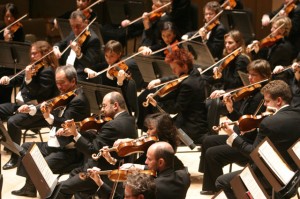
I guess that most of us think of classical music as the most proper way to play and opera as the proper way to sing but, if we really get to the heart of the matter the right music to enjoy is the music that you like the best and the one that makes you the happiest when you listen to it.
Music shapes our lives, feelings, emotions and can change your attitude quicker than any other influence. Music is a joy on every level. Yes, some may enjoy one type of music over the other while the next would prefer a different genre of music.
httpv://www.youtube.com/watch?v=dCfVpf961EI
I hope you enjoy “My Music” and send me yours at Ric@PianoSD.com and I will try and include it in upcoming features.
We opened PianoSD to be a place where people could come together and make music and have fun making music. PianoSD School of Music tries to educate people to have fun making music but at the same time do it in such a way that they learn the proper way to make music and have fun doing it.
Drop by and see us sometime we would love to meet you.
Ric Overton
Tags: bluegrass music, California, classical music, country music, gospel music, happy goodman family, harmony, have fun, jazz music, learn, Mission Valley, Ric Overton, rock music, San Diego
Posted in Guides and Information, Lessons and Tutoring, Ric Overton | Comments Off on How do you enjoy music, right or wrong ?
Friday, May 14th, 2010
We have talked about some basics in Piano regulation, Piano tuning and Piano voicing this week. I wanted to talk about Piano Moving and tell you some things that you may or may not be aware of.
While PianoSD uses Paul McCloud at Accutone Piano Service, www.pianoservsd.com for our all of our piano techinician needs. We use Precision Piano Moving at www.PrecisionPianoMoving.net for all of our moves and heres a few reasons why.
A few of the things that have to be seen and realized about moving pianos is that it is important to understand where the piano is now in relation to where it is going. For example if it is coming out of a home that is in a humid area or dry area it has to be taken into consideration.
Precision Piano Movers located in the PianoSD building in Mission Valley, San Diego, Ca moves a lot of pianos every week. We see them coming from very dry areas moving to very humid areas and vice versa. When a piano is leaving one climate for another, or from a room that is cool to a fully sunlit room the piano needs to go through an acclimation time of up to three months depending on the extremes in changes. After the acclimation time the piano should be tuned and if needed a regulation, and voicing would be in order.
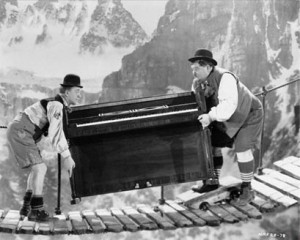 Upright pianos are generally the easiest to move. If the piano is going upstairs Precision would simply bring the necessary tools and equipment to do this. Of course, some “upright” pianos are 36″ tall while others may be up to 52″. This is important information for your movers to know BEFORE they arrive to move your piano. If the legs are decorative, they are wrapped up and blankets are put around the piano for safe keeping and then the piano is placed on a four wheel dolly and taken to the truck for transportation to its destination.
Upright pianos are generally the easiest to move. If the piano is going upstairs Precision would simply bring the necessary tools and equipment to do this. Of course, some “upright” pianos are 36″ tall while others may be up to 52″. This is important information for your movers to know BEFORE they arrive to move your piano. If the legs are decorative, they are wrapped up and blankets are put around the piano for safe keeping and then the piano is placed on a four wheel dolly and taken to the truck for transportation to its destination.
Grand pianos can be a little more challenging. Most of the time one leg is taken off and balanced on the lyre that has been very quilted for strength. It is laid on its side and stood upright. Then the other two legs and lyre come off . It is blanketed and put on a skid board, transferred to a dolly and then put on the truck for transportation. The important thing is how many steps is it going down (or up) and what kind of equipment should be used needs to be understood BEFORE the piano is moved.
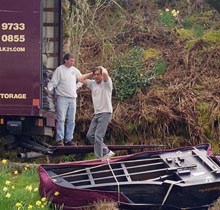 Regardless of whether the customer is using Precision Piano Moving or some other company, it is important to note that you should NEVER trust someone who is not a professional piano mover to move your piano and MOST DEFINITELY do not move it alone. To many injuries and to many accidents are caused every year by people who try to do this by themselves.
Regardless of whether the customer is using Precision Piano Moving or some other company, it is important to note that you should NEVER trust someone who is not a professional piano mover to move your piano and MOST DEFINITELY do not move it alone. To many injuries and to many accidents are caused every year by people who try to do this by themselves.
Drop by sometime we would love to meet you.
Ric Overton
Tags: Accutone Piano Service, Ca, Grand Pianos, Mission Valley, Paul McCloud, Piano Moving, piano regulation, piano technician, piano tuning, Precision Piano Moving, professional piano mover, Ric Overton, San Diego, transportation, Upright pianos, www.pianoservsd.com
Posted in Guides and Information, News, Partners, Ric Overton | 1 Comment »
Monday, May 10th, 2010
In yesterday’s blog I discussed piano tuning, today I thought I might touch on regulating a piano.
Generally speaking, regulation has little to do with the tone of the piano but, more to do with the way the piano feels while you are playing it. Each part of the piano is made of wood and wool/felt with some metal parts. On occasion the metal part needs small amounts of dry lubricant which can be applied by a technician only to help the parts move more freely.

At PianoSD.com we employ Accutone Piano Service, Paul McCloud who is a certified technician and can do this type of procedure where he takes each of the 88 keys and weighs them to be sure the down weight (the amount of weight it takes to push the piano key) is correct. He also measures the up weight (the velocity the key returns to its correct position) and makes adjustments where necessary. This can be a very tedious process because the piano technician has to insure that each piece of the piano is free to move. Dry lubricant has to be applied at the right pivot points in order to obtain the maximum benefits for the piano.
As I said in my opening that regulation will not change the tone of the piano although it may appear to if you had a completely unregulated piano to start with and the technician brings it back to its proper regulation. Paul McCloud of Accutone Piano Service here in Mission Valley at PianoSD.com will take each key individually and begin the process of being sure that each key not only weighs the right weight but, also the keys are free to move up and down and the hammers are free to move and play.
A proper regulation should take a couple of days 8-12 hours to complete if it is in really bad condition but after that the piano will most likely fell better than the day it was delivered to your home. It will feel much more balanced and almost alive. You can reach Paul McCloud of Accutone Piano Tuning at www.pianoservsd.com.
If you have questions regarding piano regulation I would be glad to help you.
Stop by sometime we would love to meet you
Ric Overton
Tags: Accutone Piano Tuning, Mission Valley, Paul McCloud, piano, piano regulation, piano tuning, Ric Overton, San Diego
Posted in Guides and Information, News, Partners, Ric Overton | Comments Off on Piano Regulation
Sunday, May 9th, 2010
I have had several people ask about piano tuning and I wanted to make a couple of comments to help people understand what this is all about.
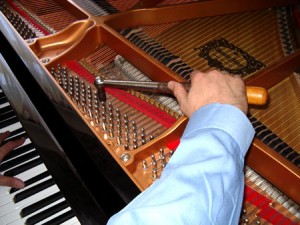 Tuning simply brings each of the strings to the right tension point in order to make the correct sound when struck by the hammer. The piano has an average of 215 to 250 strings depending on the scale design of the manufacturer. Each of these strings has to be touched or at the very least addressed by the tuner when he is in the tuning process. At PianoSD we use Accutone Piano Tuning almost exclusively http://pianoservsd.com/ . Although we have many friends who are tuners in the area, Paul McCloud is on staff here at PianoSD.com in Mission Valley, San Diego, Ca. During the tuning process and having to check that the hammers are at the right distance from the strings, the hammer strikes at the right spot on the strings, the tone, etc. can take some time. It would not be uncommon for a tuner to spend 2 to 3 hours tuning an average piano.
Tuning simply brings each of the strings to the right tension point in order to make the correct sound when struck by the hammer. The piano has an average of 215 to 250 strings depending on the scale design of the manufacturer. Each of these strings has to be touched or at the very least addressed by the tuner when he is in the tuning process. At PianoSD we use Accutone Piano Tuning almost exclusively http://pianoservsd.com/ . Although we have many friends who are tuners in the area, Paul McCloud is on staff here at PianoSD.com in Mission Valley, San Diego, Ca. During the tuning process and having to check that the hammers are at the right distance from the strings, the hammer strikes at the right spot on the strings, the tone, etc. can take some time. It would not be uncommon for a tuner to spend 2 to 3 hours tuning an average piano.
Although the climate, humdity, the time spent playing, etc. can have an affect on the sound, your piano should be tuned every six months. Even if the piano is in near perfect conditions 24/7 365 days a year, the piano should never go longer than 9 – 12 months at the very most between tunings.
The up keep on the piano is not expensive in contrast to the enjoyment or value of the instrument. Most tuners charge between $100.00 to $125.00 to tune. You should ask if they are members of the Piano Technicians Guild. You can find these technicians at www.PTG.org and simply do a search for your area.
PianoSD.com offers tuning and moving services as well as many other piano services and would be glad to help recommend someone in your area. If you need assistance with tuning or any other service please contact us here at PianoSD.
Piano tuning is as important to the life of your piano as regular maintenance is to the life and health of your car. However, please remember the piano will last longer, maintain its value longer and be in your family longer than any car you will ever own.
Drop by and see us sometime, we would love to meet you.
Ric Overton
Tags: Accutone Piano Tuning, Mision Valley, piano maintenance, piano tuning, San Diego, tuners, www.pianoservsd.com, www.PTG.org
Posted in Guides and Information, Ric Overton | Comments Off on Tuning Your Piano









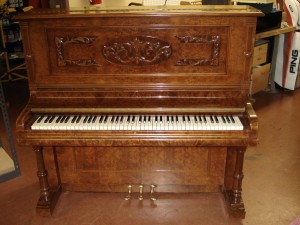



 Upright pianos are generally the easiest to move. If the piano is going upstairs Precision would simply bring the necessary tools and equipment to do this. Of course, some “upright” pianos are 36″ tall while others may be up to 52″. This is important information for your movers to know BEFORE they arrive to move your piano. If the legs are decorative, they are wrapped up and blankets are put around the piano for safe keeping and then the piano is placed on a four wheel dolly and taken to the truck for transportation to its destination.
Upright pianos are generally the easiest to move. If the piano is going upstairs Precision would simply bring the necessary tools and equipment to do this. Of course, some “upright” pianos are 36″ tall while others may be up to 52″. This is important information for your movers to know BEFORE they arrive to move your piano. If the legs are decorative, they are wrapped up and blankets are put around the piano for safe keeping and then the piano is placed on a four wheel dolly and taken to the truck for transportation to its destination.








